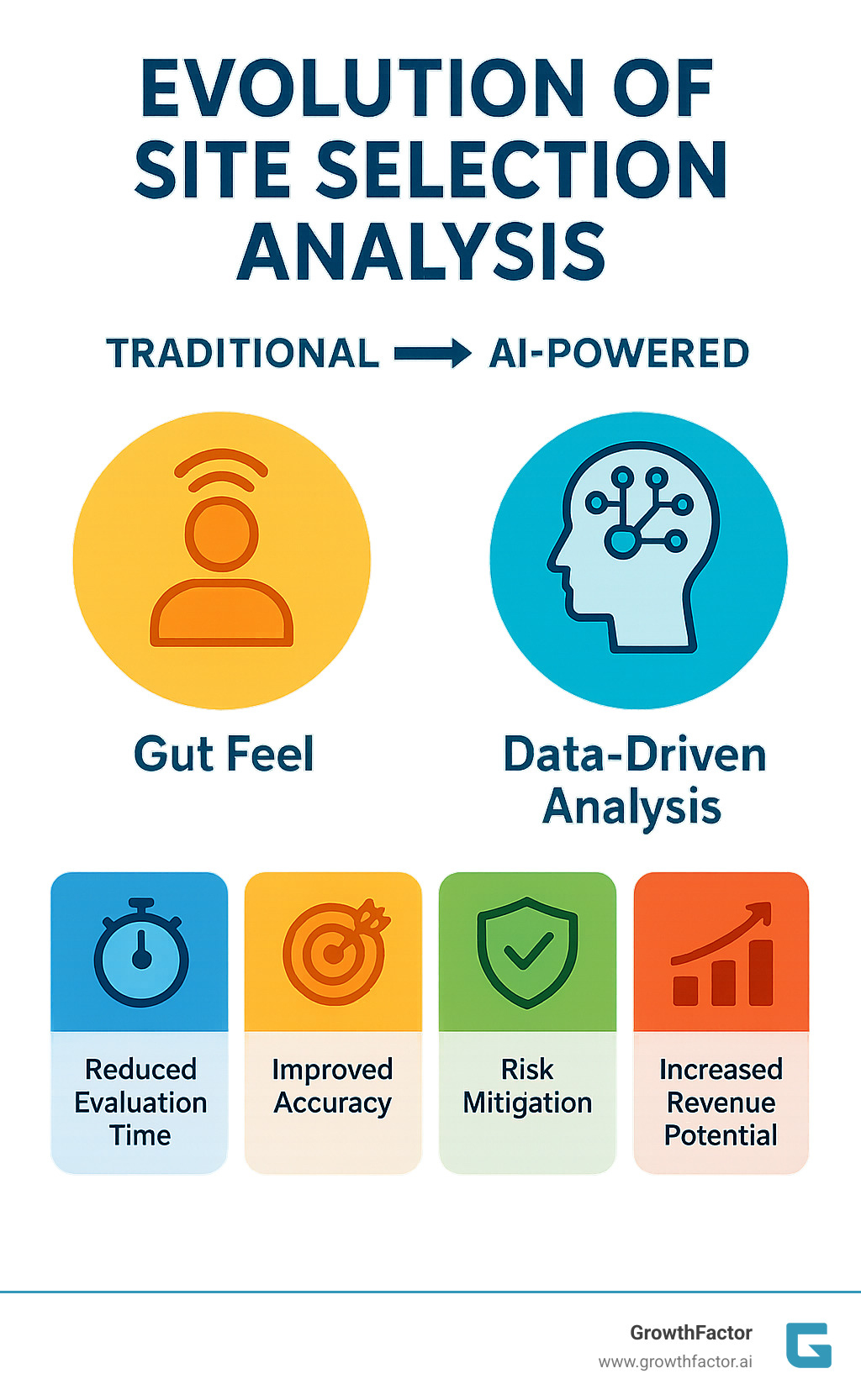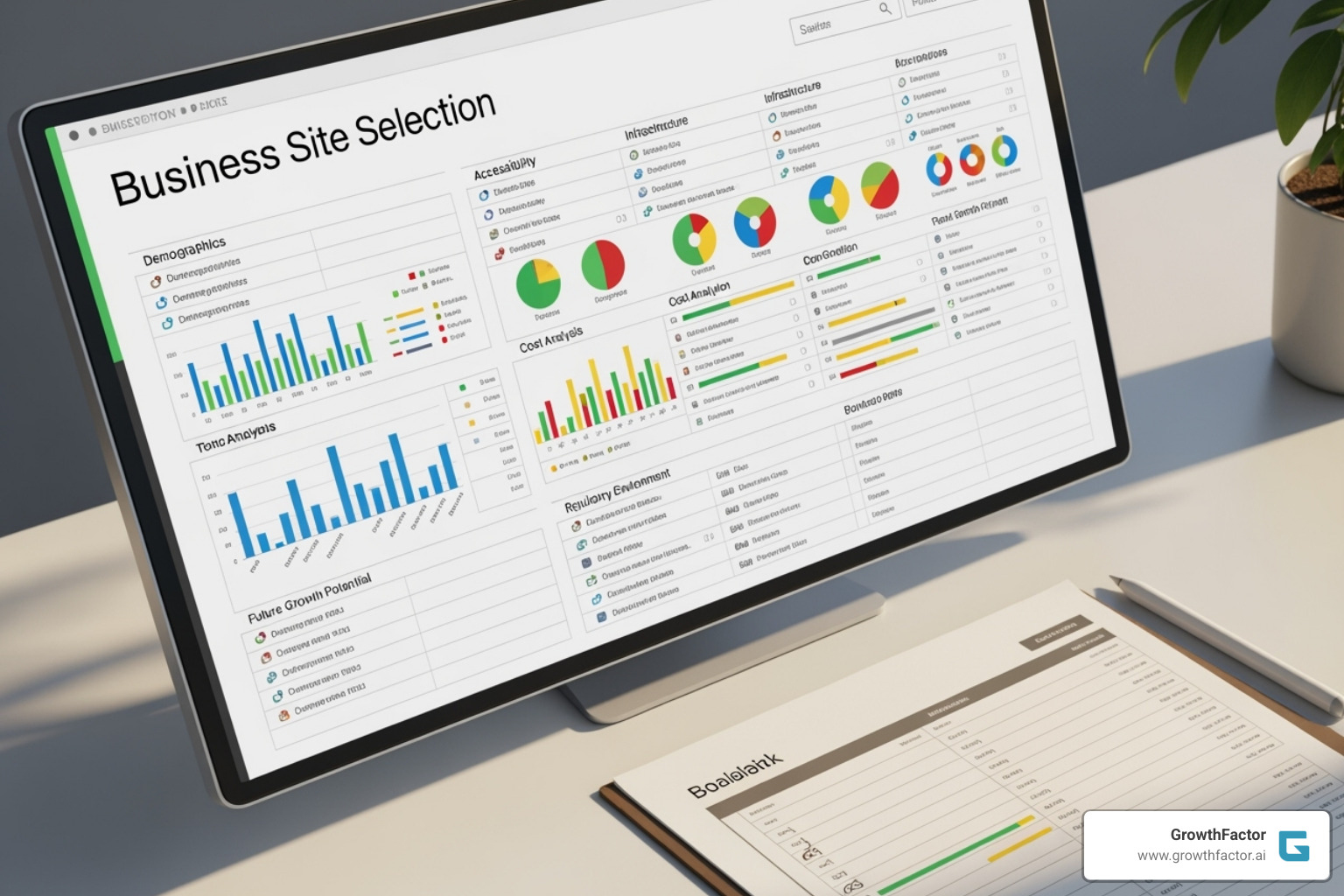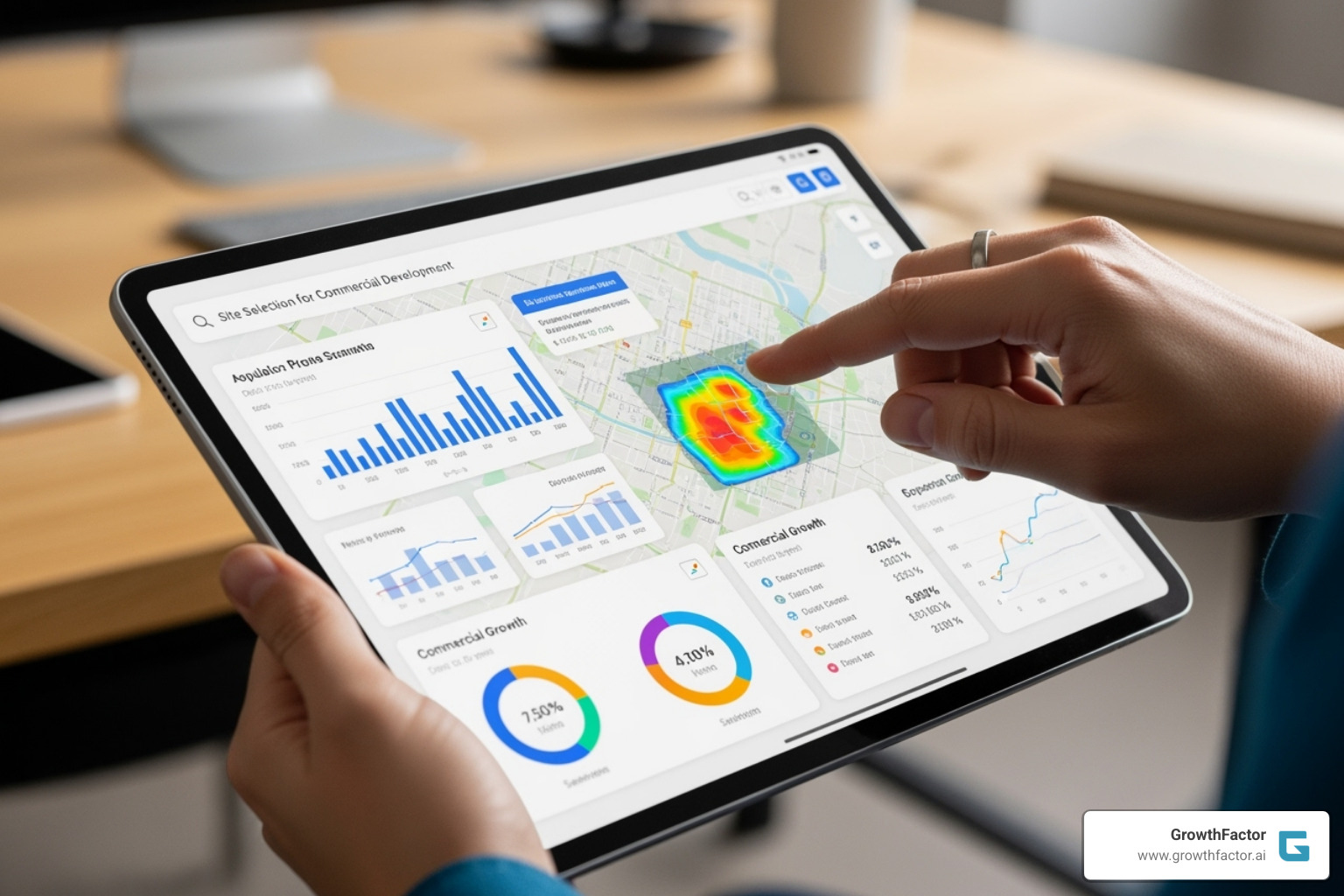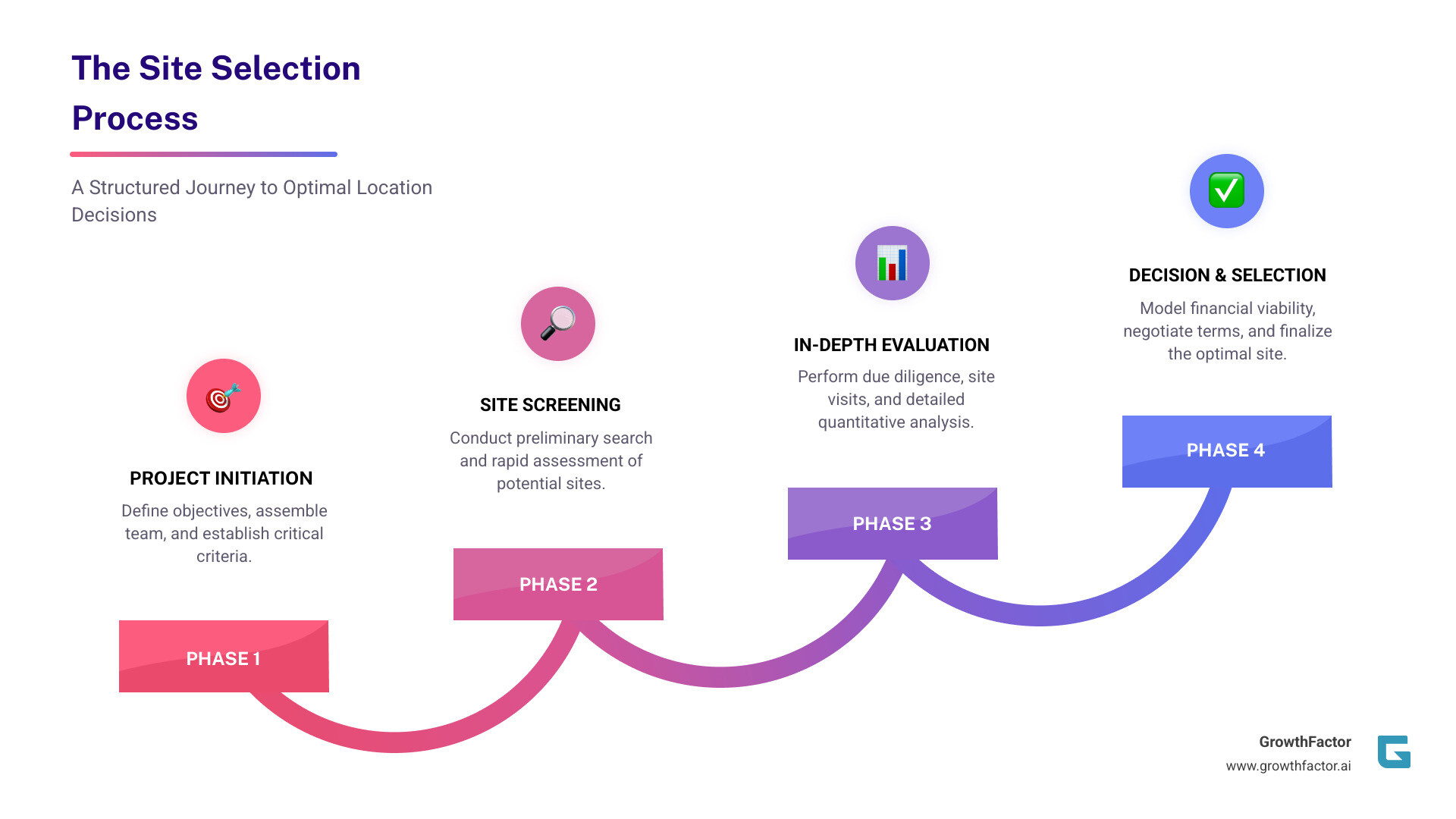**In Depth Guide to Site Selection Analysis**
Why Location Decisions Can Make or Break Your Business

Site selection analysis is the strategic process of choosing optimal locations for new business facilities through data analysis, market research, and financial modeling. For retail executives managing rapid expansion, this systematic approach transforms location decisions from risky guesswork into data-driven strategy.
Quick Overview: Site Selection Analysis Essentials
- Definition: Systematic evaluation of potential business locations using financial, demographic, and geographic data.
- Core Purpose: Minimize risk and maximize revenue potential through informed location decisions.
- Key Components: Market analysis, demographic research, competition assessment, accessibility evaluation, and cost analysis.
- Modern Approach: AI-powered platforms automate screening and provide predictive analytics.
- Business Impact: Proper analysis prevents million-dollar mistakes and open ups significant revenue opportunities.
With in-store locations still accounting for 82% of U.S. retail sales, physical placement is critical. Yet many retailers still rely on outdated methods like spreadsheets and gut feelings for these multi-million dollar choices.
Location intelligence is now essential for avoiding costly mistakes. Companies can no longer depend on outdated census data when consumer behaviors shift rapidly. The most successful retailers use sophisticated analytical models that predict performance before signing a lease.
The challenge for growing retail chains is clear: how do you efficiently evaluate hundreds of potential locations while maintaining accuracy? Traditional processes are too slow for today's market, and by the time manual analysis is complete, the best opportunities are gone.
I'm Clyde Christian Anderson, Founder and CEO of GrowthFactor.ai. We've revolutionized site selection analysis by combining AI with fractional human expertise to help retailers evaluate 5x more sites efficiently. Having worked in retail and investment banking, I experienced the frustration of spreadsheet-based decisions and built our platform to solve these exact challenges.

The Foundation of Business Expansion: What is Site Selection Analysis?
Site selection analysis is the strategic backbone of smart business expansion. It's a comprehensive evaluation that helps businesses find the perfect physical location by combining hard data with market intelligence. This systematic approach transforms location hunting from a guessing game into a predictable science.
Think of it as your business's GPS for growth. It blends financial analysis, demographic research, and geographic assessment to create a complete picture of each potential location's opportunity and risk.

Why does this matter? The right spot can drive traffic, reduce costs, and boost profitability for years. The wrong choice leads to empty stores and wasted capital. Site selection analysis is crucial for avoiding costly mistakes, maximizing customer reach, and ensuring long-term growth. It's the difference between a struggling store and one that exceeds revenue projections from month one.
To dig deeper into the fundamental definition, explore our guide on What is Site Selection.
The Shift from Art to Science
Not long ago, choosing a business location involved driving around neighborhoods and trusting gut instincts. While this approach sometimes worked, it was wildly inconsistent and risky.
The evolution to data-driven science was a necessary response to a more complex retail environment. With increased competition and changing consumer behavior, there's no room for error. Modern site selection analysis uses sophisticated models to forecast sales, understand customer demographics, and identify potential challenges before you sign a lease, replacing guesswork with precision.
Learn more about this change in our article on Data-Driven Site Selection.
Why Outdated Data is a Liability
Relying on outdated census data is a major liability when neighborhoods and consumer preferences shift rapidly. A quiet area can become a commercial hub almost overnight, and spending habits evolve with economic trends and technology.
The limitations of census data are clear: it captures a snapshot of the past, not the dynamic reality of today. Fast-changing consumer trends mean yesterday's shopping patterns are irrelevant for tomorrow's decisions. Real-time information has become critical.
Dynamic market analysis tracks foot traffic, monitors demographic shifts, and analyzes spending behaviors as they happen. This gives you the current picture needed to make confident location decisions, not outdated information that could lead you astray.
Core Criteria: Key Factors Driving Site Selection Decisions
Success in site selection analysis lies in the details. A comprehensive evaluation prevents the costly mistake of choosing a location with a fatal flaw, like restrictive zoning or a mismatched customer base. Before diving in, start with a thorough needs assessment to ensure every factor you evaluate aligns with your business goals.

For a detailed breakdown of what to prioritize, refer to our comprehensive guide on Store Site Selection Criteria.
Demographics and Psychographics
Understanding your customers is the foundation of smart location decisions. Population density tells you how many potential customers are nearby, but deeper insights are crucial.
- Income levels must align with your price point.
- Age distribution ensures you're targeting the right generation.
- Consumer spending habits reveal if there's genuine demand for your offerings.
- Lifestyle preferences (psychographics) often matter more than basic demographics, helping you find customers who share your brand's values.
The goal is to find where your ideal customers already live, work, and play.
Dive deeper into understanding your audience with our insights on Retail Location Analysis.
Accessibility, Competition, and Labor Force
These three factors determine if your location is findable, viable, and sustainable.
- Accessibility: Good visibility, high foot traffic, and proximity to main roads and public transit are key. Don't forget parking availability; a good rule is three square feet of parking for every square foot of store space.
- Competition: Analyze both direct and indirect competitors. Sometimes, proximity to complementary businesses (co-tenancy) creates synergy, attracting a shared customer base and creating a stronger retail destination.
- Labor Force: Ensure you can staff your location. Consider the availability of qualified workers, local wage rates, and workforce stability.
Transportation infrastructure plays a crucial role in all these factors, as highlighted by research on The Role of Transportation Investment in Private Firm Site Selection.
Evaluating Costs and Financial Viability
The monthly rent is just the start. A full financial analysis prevents hidden costs from draining profits. Consider:
- Property taxes
- Utility costs
- Renovation expenses
- Maintenance fees (including CAM charges)
Also, investigate economic incentives. Local, state, and federal governments often offer tax breaks or grants to attract new businesses, which can significantly improve your ROI.
For a deeper dive into assessing financial feasibility, check out our insights on Real Estate Feasibility Study.
Zoning, Regulations, and Environmental Factors
Skipping legal and environmental due diligence is a recipe for disaster.
- Zoning and Regulations: Confirm permitted uses for the property and understand local building codes and signage restrictions.
- Environmental Factors: Conduct assessments to check for issues like soil contamination or flood risks, which can create future liabilities.
- Compliance: Ensure you can meet all business licensing, health, and safety regulations. Lack of community support can also block otherwise viable projects.
A comprehensive due diligence process protects your investment and prevents costly delays. Learn more about its importance in Property Due Diligence.
The Tech Revolution: How Data and AI Are Changing Site Selection
The world of site selection analysis has been transformed by technology. Gut feelings and spreadsheets are being replaced by location intelligence, geospatial data (GIS), and predictive modeling, turning guesswork into a precise science.

This revolution enables businesses to evaluate five times more sites with greater accuracy. At GrowthFactor, our AI Agent Waldo automates the tedious qualification and evaluation processes, freeing up teams to focus on strategy. While competitors manually analyze a few locations, AI-powered platforms can evaluate hundreds simultaneously, spotting opportunities that would otherwise be missed.
Find how technology is reshaping location strategies in our comprehensive guide on AI Location Intelligence.
The Role of Data in Modern Site Selection Analysis
Modern analysis thrives on integrating diverse data streams to build a complete picture of a site's potential.
- Demographic data (age, income, population density) reveals if your target customer lives nearby.
- Foot traffic data shows where people actually go, revealing real visitation patterns and cross-shopping behaviors.
- Consumer spending data uncovers the economic reality of an area, helping predict performance and identify underserved markets.
- Psychographic data goes deeper to understand lifestyles and values, which is critical for brand affinity.
- Geographic and historical data (crime rates, zoning, development plans) provides context for assessing long-term viability.
| Data Type | Key Insights | Business Impact |
|---|---|---|
| Demographic | Population density, income, age distribution | Target market alignment |
| Foot Traffic | Visitation patterns, cross-shopping behavior | Performance prediction |
| Consumer Spending | Category spending patterns, market demand | Revenue forecasting |
| Psychographic | Lifestyle preferences, values, behaviors | Brand positioning |
| Geographic | Safety, development plans, zoning | Risk assessment |
Layering these datasets is key. A location might look perfect demographically but have poor foot traffic. Combining data sources minimizes risks and maximizes opportunities.
Learn more about the full spectrum of available data in our detailed breakdown of Site Selection Data.
AI-Powered Platforms and Automation
AI-powered platforms make site selection analysis fundamentally more intelligent. Our AI Agent Waldo automates the manual work of sifting through hundreds of properties, allowing human analysts to focus on high-level strategy.
- Sales forecasting becomes remarkably precise when AI analyzes historical data, market trends, and demographics simultaneously.
- Whitespace analysis reveals untapped markets with high demand and low competition.
- Cannibalization risk assessment protects your existing network by predicting if a new store will steal customers from a current one.
This automation streamlines the entire workflow, shifting teams from spreadsheet work to strategic thinking. The result is a dramatic gain in efficiency and accuracy, making enterprise-level analysis accessible to growing retailers.
Explore how AI is changing retail location strategies with AI for Retail Site Selection and find how we're helping teams End the Era of Spreadsheet Purgatory: How AI is Revolutionizing Retail Site Selection.
A Step-by-Step Guide to the Site Selection Analysis Process
Site selection analysis follows a structured five-phase journey from initial brainstorming to signing a lease. This methodical approach ensures every critical factor gets proper attention, preventing costly dead ends.

For a comprehensive roadmap of this entire journey, check out our detailed guide on the Retail Site Selection Process.
Phase 1 & 2: Project Initiation and Site Screening
Success starts with a clear plan and the right team.
- Build your team: Assemble representatives from real estate, operations, finance, and leadership. Each perspective is vital.
- Define your objectives: Clarify your goals. Are you building brand awareness, chasing revenue, or testing a new concept? Your "why" shapes every decision.
- Establish clear criteria: Transform preferences into measurable standards (e.g., specify minimum daily foot traffic instead of just "good foot traffic").
- Screen sites with technology: Instead of driving around, use modern tools to cast a wide net. Our AI Agent Waldo can rapidly evaluate countless properties against your criteria, surfacing hidden gems and eliminating mismatches. This allows teams to evaluate 5x more sites than traditional methods.
Our guide on How to Choose Retail Location dives deeper into these crucial first steps.
Phase 3 & 4: In-Depth Evaluation and Decision Making
With a shortlist of sites, it's time for a deep dive.
- Site visits: These are irreplaceable. Walk the neighborhood to observe traffic patterns and get a feel for the area that data can't capture.
- Due diligence: Research ownership history, environmental reports, and zoning restrictions to uncover potential deal-breakers.
- Quantitative analysis: Create detailed financial models for each site, factoring in all costs, revenues, and potential incentives. Use weighted criteria to score and rank sites objectively, removing emotional bias.
- Qualitative analysis: Balance the numbers with human insight. Consider community reception, long-term growth potential, and strategic fit.
- Negotiating terms: Once you've chosen a site, negotiate not just the price but also tenant improvement allowances and other favorable terms.
The financial modeling aspect deserves special attention, which is why we've created detailed guidance in our Real Estate Deal Analysis resource.
Common Challenges and Best Practices
Even with the best tools, site selection presents common challenges.
- Data limitations: Gaps in data are common. The solution is to leverage multiple data sources and cross-reference information to build a complete picture.
- Analysis paralysis: The sheer volume of data can be overwhelming. Combat this by establishing a clear evaluation framework and decision deadlines. AI helps cut through the complexity by highlighting what truly matters.
- Securing stakeholder buy-in: Involve all stakeholders from the beginning to prevent last-minute objections. Transparent data and clear explanations build consensus.
- Ignoring market shifts: Markets evolve constantly. Use real-time data and trend analysis to make decisions based on tomorrow's opportunity, not yesterday's reality.
- Failing to prioritize criteria: A convenience store has different needs than a destination retailer. Prioritize criteria based on your specific business model to keep your analysis focused.
Conducting a Comprehensive Site Selection Analysis by Industry
Adapt your approach to your industry's unique success drivers.
- Retail: Convenience-based retailers (e.g., QSRs) prioritize easy access and parking. Destination retailers (e.g., furniture stores) can be less central but need good regional access. Understanding the competitive landscape—whether it's synergistic or cannibalistic—is also key.
- Industrial: Manufacturing and distribution centers prioritize transportation networks (highways, ports, rail), infrastructure capacity (power, water), and labor availability. For logistics, freight costs are often the single biggest driver of competitiveness.
- Commercial: Office and mixed-use projects focus on access to an educated workforce, public transit, and quality of life amenities that attract and retain talent.
Our specialized approach for different business types is detailed in our Retail Store Site Selection guide.
Conclusion
Site selection analysis has evolved from an intuitive art into a data-driven science, a critical process for any business expansion. The right location is fundamental to success, yet many companies still risk million-dollar investments on gut feelings and outdated information.
Successful analysis requires balancing demographics, accessibility, competition, and financial viability. The true game-changer, however, is modern technology. AI-powered platforms have revolutionized location decisions, enabling businesses to evaluate hundreds of sites with unprecedented speed and accuracy.
At GrowthFactor, we see how our AI Agent Waldo gives teams a competitive edge, allowing them to evaluate five times more sites and move forward with data-backed confidence while others are still stuck in spreadsheets. By combining a systematic process with cutting-edge technology, you can transform a complex challenge into a strategic advantage.
The future of site selection belongs to businesses that accept both rigorous analysis and innovative technology. Every location decision is an investment in your company's future. Make sure it's a smart one.
Ready to transform your site selection process? Empower your team with an all-in-one platform for site selection and find how modern technology can turn your next location decision into your best strategic move yet.
Citations
The human algorithm
Ready to see what we're cooking?
Submit your information below and we'll be in touch to schedule.







